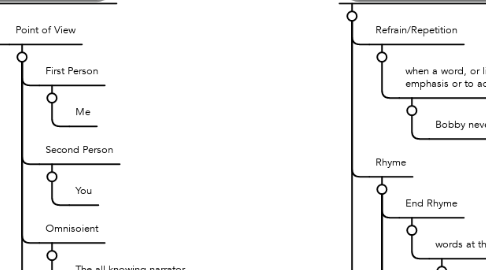
1. Literary Techniques
1.1. Flashbacks
1.1.1. used to tell a story or event from the past
1.1.1.1. He remembered his childhood
1.2. Foreshadowing
1.2.1. a hint that something will happen
1.2.1.1. a character dreams of something and then it happens
1.3. Irony
1.3.1. a contrast between expectation and reality
1.3.1.1. choking on a lifesaver
1.4. Mood/Atmosphere
1.4.1. gives the emotional feeling the reader receives
1.4.1.1. happy, sad, nostalgic
1.5. Motif
1.5.1. a repeating feeling, image or message
1.5.1.1. a character continues to see mirrors everywhere he goes
1.6. Suspence
1.6.1. keeps the readers reading/ what the reader wants to know/ anticipation
1.6.1.1. Will the character live
1.7. Tone
1.7.1. attitude the writer takes towards the events in the story
1.7.1.1. humour, passion, sincere
1.8. Poetic and Dramatic Devices
1.8.1. Refrain/Repetition
1.8.1.1. when a word, or line is repeated - used for emphasis or to add meaning
1.8.1.1.1. Bobby never ate. Bobby never ate.
1.8.2. Rhyme
1.8.2.1. End Rhyme
1.8.2.1.1. words at the end of phrases rhyme
1.8.2.2. Internal Rhyme
1.8.2.2.1. two or more words within the same line rhyme
1.8.2.3. Rhyming Couplet
1.8.2.3.1. rhyming pattern is a, a, b,b
1.8.2.4. Rhyme
1.8.2.4.1. two or more words have the same sound
1.8.3. Soilioguy
1.8.3.1. When an actor goes on stage and talks to the audience
1.9. gives special effect on the reader
1.10. normally more than one type of literary techniques are used in a piece of literature
2. Literary Elements
2.1. Point of View
2.1.1. First Person
2.1.1.1. Me
2.1.2. Second Person
2.1.2.1. You
2.1.3. Omnisoient
2.1.3.1. The all knowing narrator
2.1.4. Third Person
2.1.4.1. Limited
2.1.4.1.1. knows thoughts and feelings of all characteres
2.1.4.2. Objective
2.1.4.2.1. Only knows thoughts and feeling of one character
2.1.4.3. They, he, she, it
2.1.4.4. Knows what is physical happening
2.2. Setting
2.2.1. the time, place, or mood
2.3. Character
2.3.1. dynamic
2.3.1.1. changes because of what is happening in the story
2.3.2. static
2.3.2.1. changes very little or not at all
2.3.3. motivation
2.3.3.1. what makes a character act in a certain way
2.4. Theme
2.4.1. what the piece of literature is about or the message
2.4.1.1. theme is a statement - not a single word or phrase
2.5. Plot
2.5.1. map of the story, sequence of events
2.5.2. five main points
2.5.2.1. exposition
2.5.2.1.1. beginning of the story
2.5.2.2. rising action
2.5.2.2.1. action happening
2.5.2.3. climax
2.5.2.3.1. the high point of the action
2.5.2.4. falling action
2.5.2.4.1. the cool down after the climax
2.5.2.5. resolution
2.5.2.5.1. the conclusion of the story
2.6. Conflict
2.6.1. the struggle between forces/ characters
2.6.2. creates the plot
2.6.3. inciting incident sets the story in motion
2.6.4. Four main types
2.6.4.1. person vs person
2.6.4.1.1. conflict between two people
2.6.4.2. person vs nature
2.6.4.2.1. conflict between person and forces of nature
2.6.4.3. person vs society
2.6.4.3.1. conflict between person and views of society
2.6.4.4. person vs self
2.6.4.4.1. internal conflict
2.6.4.5. character vs super natural
2.7. Characterization
2.7.1. reveals personality of the character
2.7.2. protangonist
2.7.2.1. the main character
2.7.3. antogonist
2.7.3.1. the character that opposes the protagonist
3. Poetic and Dramatic Devices
3.1. Refrain/Repetition
3.1.1. when a word, or line is repeated - used for emphasis or to add meaning
3.1.1.1. Bobby never ate. Bobby never ate.
3.2. Rhyme
3.2.1. End Rhyme
3.2.1.1. words at the end of phrases rhyme
3.2.1.1.1. We went to the store. We found it a bore.
3.2.2. Internal Rhyme
3.2.2.1. two or more words within the same line rhyme
3.2.2.1.1. How did the cat get so fat?
3.2.3. Rhyming Couplet
3.2.3.1. rhyming pattern is a, a, b,b
3.2.4. Rhyme
3.2.4.1. two or more words have the same sound
3.2.4.1.1. bat, cat, rat
3.3. Soilioguy
3.3.1. When an actor goes on stage and talks to the audience
4. Figurative Language
4.1. alliteration
4.1.1. repetition of sound normally at the beginning of words
4.1.1.1. Peter, piper, picked a peck of pickled peppers
4.2. allusion
4.2.1. a reference to anything outside of the work of literature
4.3. hyperbole
4.3.1. used to show emphasis on a point/ an exaggerated statement
4.3.1.1. It was raining cats and dogs
4.4. idom
4.4.1. an expression that plays with language and is not the literal meaning
4.4.1.1. Hold your tongue
4.5. imagery
4.5.1. makes you image what is happening, includes all sentences
4.5.1.1. It was a dark and stormy night
4.6. metaphor
4.6.1. a comparison without using like or as
4.6.1.1. The cotton candy is a cloud
4.7. Oxymoron
4.7.1. Contains two contradictory words
4.7.1.1. What a smart fool!
4.8. Onomatopoeia
4.8.1. a word that sounds the way it is written, makes a sounds
4.8.1.1. BOOM!!!
4.9. Personification
4.9.1. gives an animal or object human traits
4.9.1.1. The Bee Movie
4.10. Slime
4.10.1. A comparisons using like or as
4.10.1.1. the cloud was like cotton candy
4.11. Symbol
4.11.1. has a deep meaning
4.11.1.1. life
4.12. Symbolism
4.13. Literary Techniques
4.13.1. Flashbacks
4.13.1.1. used to tell a story or event from the past
4.13.1.1.1. He remembered his childhood
4.13.2. Foreshadowing
4.13.2.1. a hint that something will happen
4.13.2.1.1. a character dreams of something and then it happens
4.13.3. Irony
4.13.3.1. a contrast between expectation and reality
4.13.3.1.1. choking on a lifesaver
4.13.4. Mood/Atmosphere
4.13.4.1. gives the emotional feeling the reader receives
4.13.4.1.1. happy, sad, nostalgic
4.13.5. Motif
4.13.5.1. a repeating feeling, image or message
4.13.5.1.1. a character continues to see mirrors everywhere he goes
4.13.6. Suspence
4.13.6.1. keeps the readers reading/ what the reader wants to know/ anticipation
4.13.6.1.1. Will the character live
4.13.7. Tone
4.13.7.1. attitude the writer takes towards the events in the story
4.13.7.1.1. humour, passion, sincere
4.13.8. gives special effect on the reader
4.13.9. normally more than one type of literary techniques are used in a piece of literature

